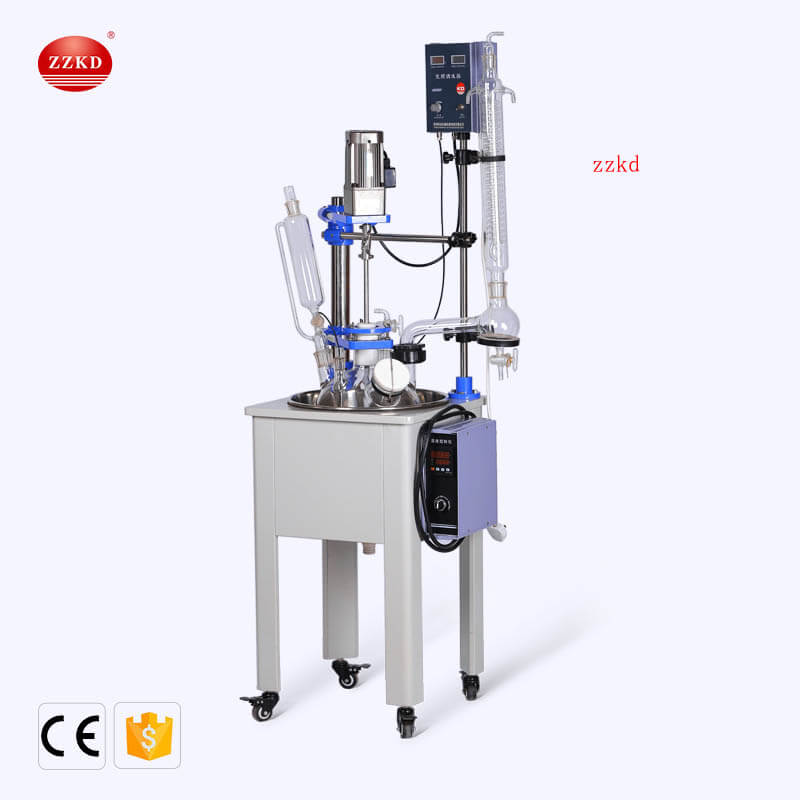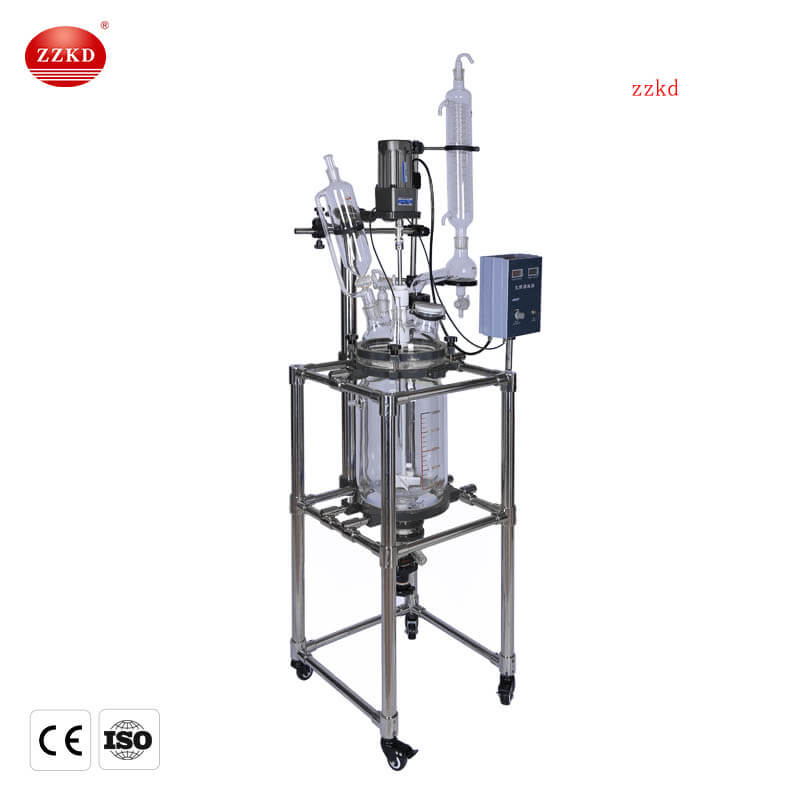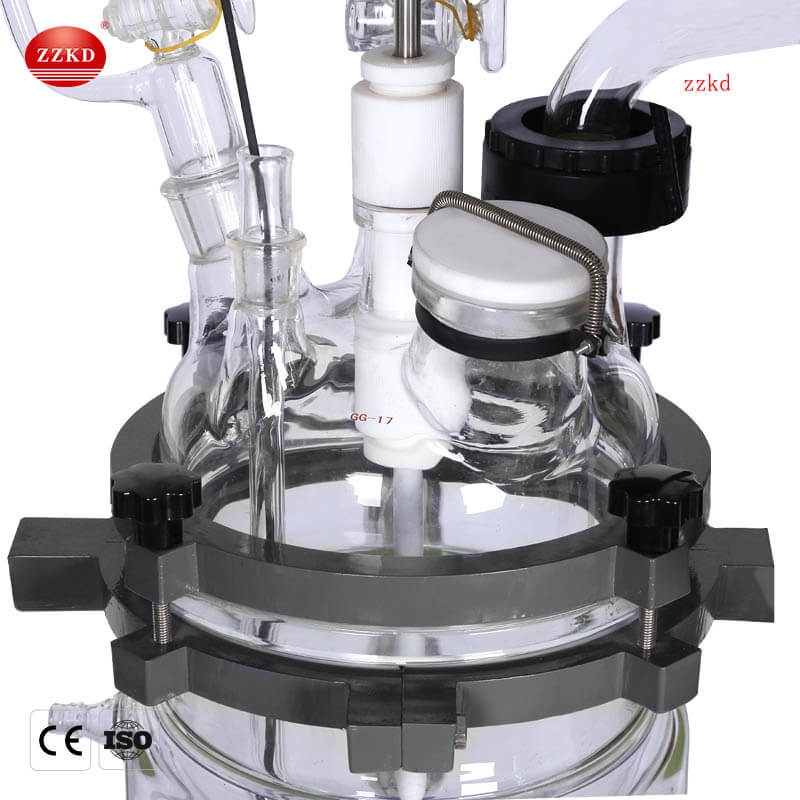Single Layer / Double-layer 20l Glass Response Kettle
The 100l glass reactor is widely used and is a commonly used biochemical instrument in the industry. Therefore, it is widely used in modern fine chemicals, scientific research experiments, biopharmaceuticals, colleges and universities, etc. It is an ideal type for teaching, experimentation, production and pilot testing. equipment. The quality of our glass reactor is guaranteed, the price is moderate, the large inventory does not delay the delivery time, the packaging is rigorous, and the after-sales service is perfect. If the glass is damaged due to express delivery or other reasons, our company can replace it for you for free.
As a glass reactor manufacturer, we are naturally very familiar with the use of glass reactors. But for some customers who are new to glass reactors, they may wonder what glass reactors are used for? So today, Zhengzhou Bohui will summarize the uses of glass reactors for you. I hope this article can relieve your doubts. Let you understand the use of glass reactor.

In fact, the glass reactor is only one of many reactors. Other reactors also include glass-lined reactors, hydrothermal synthesis reactors, magnetic stirring reactors, electric heating reactors and steam reactors. But the most frequently used one is the glass reactor. The glass reactor has the characteristics of pollution-free, high temperature resistance, corrosion resistance, sanitation, and fast heating speed. The reaction can control the reflux and evaporation of the solution. There are single-layer, double-layer and triple-layer glass reactors.
The glass reactor is mainly used for experiments such as material distillation, synthesis and concentration. The kettle can be pumped to a negative pressure state to meet different experimental conditions. The material can be evenly added dropwise through the constant pressure funnel or the valve on the feeding bottle; the distillation or reflux of the solvent can be realized by using the heat exchange function of the condenser. The body of the single-layer glass reactor has no interlayer. The double-layer glass reactor has a single-layer structure. The interlayer can adjust the temperature of the material in the kettle through the external temperature control circulation device and the circulating liquid. The body of the triple-layer glass reactor is a double-layered structure. The inner interlayer is connected to the temperature control circulation device, and the temperature of the material in the kettle is adjusted by the circulating liquid; the outer interlayer can be pumped to a negative pressure state to realize the vacuum temperature insulation function, which can prevent the kettle body from frosting under low temperature conditions, and facilitate the observation of the reaction conditions in the kettle.
The glass reaction system package includes: glass unit, stirring unit and integral support. The overall bracket and the kettle body fixture of the reaction kettle are specially designed and processed, which is convenient for users to quickly install/disassemble the whole system for easy replacement and cleaning.
The use of glass reactor can be summarized into the following aspects: high temperature reaction (maximum G temperature can reach 200 ℃), low temperature reaction (low temperature can reach -80 ℃), vacuuming for negative pressure reaction, solvent synthesis reaction at constant temperature , distillation reflux reaction, vacuum distillation reaction, separation and extraction reaction, purification reaction, concentration reaction, stirring reaction, etc. According to different use conditions and requirements, users can adjust the use temperature and pressure to adapt to different experimental environments.
Double Layer Glass Reactor 10l
The glass reaction kettle mainly uses its double-layer glass characteristics. We can place the reaction material (somewhat called the reaction solvent) in the middle interlayer, and by stirring the reaction under normal pressure or negative pressure, the glass reaction kettle can pass the double-layer reaction. The kettle interlayer is injected with a constant temperature (high temperature or low temperature) hot solution or cooling liquid to heat or cool the materials in the reactor at a constant temperature, and can provide stirring. In this way, the medium in the interlayer of the glass reactor (such as: freezing liquid, heating water or heating oil, etc.) is heated or cooled by stirring to perform a cyclic reaction.

The frequency conversion speed regulation double-layer glass reaction kettle can be used in the high temperature range from 200℃ to low temperature -80℃; the polytetrafluoroethylene (PTFE) components are sealed and specially designed to maintain the vacuum degree of similar products in the market (about -0.098mpa) , The discharge valve can release concentrated liquid and trace solid materials; the surface of the bracket is sprayed with Teflon, which is resistant to strong corrosion and maintains the aesthetics and service life of the whole machine. (Also optional spray)
Laboratory 2l Mini Mixing Chemical Reactor
S-10L S-20L S-30L S-50L double-layer glass reactor is a new kind of frequency conversion speed-regulated double-layer glass reactor developed and produced by our firm. It absorbs the advantages of similar products at home and overseas. The double-layer glass reactor produced by our firm is easy to operate, The appearance is gorgeous and generous, and the construction is novel and sensible. It is an ideal experiment and manufacturing equipment for biopharmaceutical and new materials preparation. TEFIC single glass reactor consists of a mechanical half, the governor, the heating portion and the glass a half of the four main parts of its construction. Batch 5L jacketed glass reactor with cryogenic pump, water/oil bathtub and vacuum pump for elevated productivity.
The 100l glass reactor is a large glass reactor vessel produced by our company. It has universal casters and may be very handy to move. This product can be used along with the vacuum pump to enhance work efficiency; it can be used together with the low-temperature coolant circulating pump to enhance the recycling efficiency. Customers are suggested to buy matching gear. The large-capacity glass reactor vessels we produce have common casters which are very handy to maneuver.

Precautions:
1. Each standard port, ball grinding port and sealing surface should be coated with a small amount of vacuum silicone grease to increase air tightness.
2. The life of the electrical box is greatly affected by the surrounding temperature and humidity. Keep the governor and motor dry.
3. All glass parts should be cleaned before installation.
4. No-load operation is not suitable for high-speed operation.
5. Install the reactor equipment first and then operate the equipment by professional operators.
6. Before installation, use, maintenance, and inspection, be sure to read all the contents of this manual carefully and use it correctly.
If you need to make an inquiry, we will give you a quotation at the i-th time.


